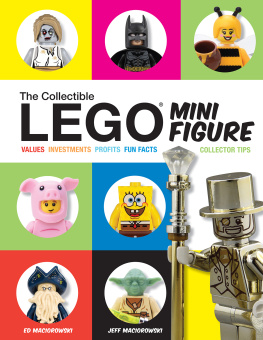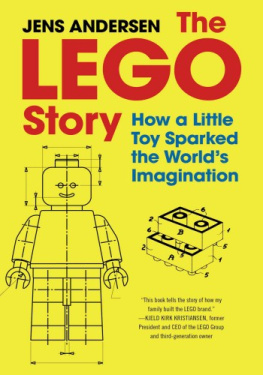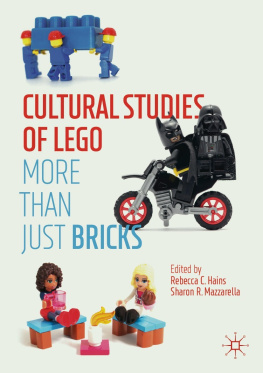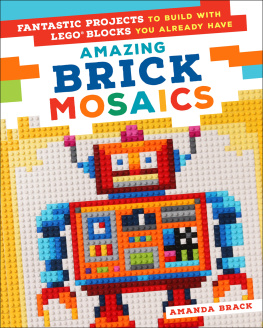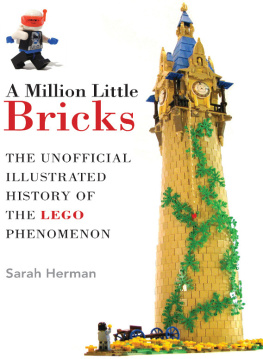Contents
Guide
The Ultimate Guide to Collectible
LEGO SETS
Identification and Price Guide
Ed Maciorowski
Jeff Maciorowski
CONTENTS
INTRODUCTION
LEGO bricks. For over 50 years, these tiny pieces of plastic have won over the hearts and minds of millions of children and adults across the world. The popularity of these building bricks has grown exponentially over the years, with LEGO being named the Toy of the Century by the British Association of Toy Retailers and originally by Fortune magazine in 2000. This popularity has helped LEGO become the number one toy maker in the world in 2013, and outperform rival toy maker, Mattel, in terms of revenue and profit. But the profits dont stop with The LEGO Group or other retailers.
I have been a fan and collector of LEGO bricks and sets for almost 40 years, but it wasnt until about the last seven that the secondary LEGO marketplace caught my attention. With the advent of the internet and auction sites like eBay, a huge market for retired sets has developed over the past decade or so. I was amazed at the values of some of the more exclusive and rare LEGO sets. Even regular non-exclusive sets, many with standard features, designs, and brick types, increase in value after retirement. It was this growth in value of retired LEGO sets that started me and my brother, Jeff, on a quest to track these values in an accurate and updated manner.
eBay has played a huge role in the growth of the LEGO secondary market. The site has become a multimillion-dollar marketplace for vintage and retired items, and is the largest marketplace for new and used LEGO sets and pieces on the planet. On any given day, there are tens of thousands of transactions that deal with LEGO sets and pieces. Terapeak market research collects this sales data from eBay and we aggregate that data into our price guide, filtering out bad listings and removing outliers. We aggregate data from thousands of completed eBay LEGO auctions on a monthly basis. The data in this book is the most recent sales information that was available before the book went to press.
THE BASICS
There have been approximately 10,000 LEGO sets created over the past 50 years. What makes a set a valuable collectible is that each one has a limited production run some a couple of months, some several years. The more unique and rare a set, usually the higher the value it has. The one factor that works differently from other collectibles is age. Older is not always more valuable. Some sets will plateau and may even drop in value over time. LEGO sets are valuable because of a connection of a potential buyer to a set. Many current fans are unfamiliar with old sets and place little value on them, yet some newer sets can fetch thousands of dollars. A potential buyer might have wanted a set as a child and could not afford it, so when they get older and have some extra discretionary income, they pay top dollar for that retired set. Other sets are bought by collectors who are completists and enjoy collecting entire themes. There are many reasons why sets are valuable. They are iconic toys, are creative, and exceptionally produced, but they mostly create a bond with fans and future buyers.
For our purposes in this book, we are sticking with sets that were created and released from 2000 and after, but we do include prices and analysis for a handful of pre-2000, or vintage, sets. Besides being more relative to many fans and collectors, sets that were created after 1999 are on a different level of creativity and complexity. In addition to a change in set design, bold business decisions by LEGO to add licensed movie/TV properties such as Star Wars, Harry Potter, and The Lord of the Rings, have paid off considerably. The first and foremost of these more elaborate, licensed themes is the Star Wars Ultimate Collector Series, which launched in 2000. The UCS sets are more complex builds and accurate in appearance. They are large sets, designed with adult fans in mind. But even the smaller, more cost-effective licensed sets help drive new fans to LEGO. With every new Star Wars or Harry Potter movie, children flock to the stores to buy new sets based on it. Non-licensed themes also benefited from the more intricate designs and larger set sizes. The largest retail LEGO set ever produced (piece count), the 10189 Taj Mahal, is a beautiful rendition of one of the Wonders of the World. LEGO is no longer a toy for just children, and this change in philosophy helped pave the way to The LEGO Groups financial success today. Now adults are buying sets for themselves and this practice drives up prices on many new and retired sets.
The fact that all LEGO sets do retire at some point creates a limited time to buy them from primary retailers. Short-term resellers and long-term investors capitalize on this and will stock up on new sets, waiting for a LEGO set to retire or go EOL (end of line), then will proceed to list these retired sets on eBay at a price higher than the manufacturers suggested retail price. Some resellers even flip sets short term, basically reselling a hot or popular LEGO set before they retire. This usually occurs around Christmas or when a popular set is in short supply.
The main goal of this book is to show current market prices on many of the most popular sets in recent history. You might be surprised at what you read. That set purchased for Little Johnny three years ago might be worth more now used than you paid for it new. You will find that all sets are not created equal and that there are themes that appreciate well and others that do not. Also, the size of sets with regards to piece count and weight can also play an important factor in the value. LEGO bases their MSRPs on the weight of a set, for the most part. The more ABS (acrylonitrile butadiene styrene) plastic used to produce a set, the more it will cost at retail and on the secondary market. LEGO minifigures also play a major role in the value of set, and these peanut-sized plastic people produce huge profit potential. Many of the most valuable and profitable LEGO sets are because of a rare minifigure or it contains multiple minifigures.
HOW TO USE THIS BOOK
Each chapter in this book is based on a major LEGO theme and organized alphabetically. The most important themes are included, but a few less popular themes, such as Prince of Persia, Atlantis, and World Racers, are discussed briefly in the , the definition of ROI is as follows:
A performance measure used to evaluate the efficiency of an investment or to compare the efficiency of a number of different investments. To calculate ROI, the benefit (return) of an investment is divided by the cost of the investment; the result is expressed as a percentage or a ratio. The return on investment formula:

For our ROI calculations, the cost of investment is the MSRP of the LEGO set and the gain from investment is the current market price according to our data. We also include a basic list that ranks a multitude of sets from a theme according to their Return on Investment from MSRP. By analyzing some of the top sets from each theme, a smart and savvy LEGO fan might be able to pick out qualities that make certain sets valuable and qualities that produce investment losers. There is a separate price guide in the back of the book that lists more sets in each theme and their values.


